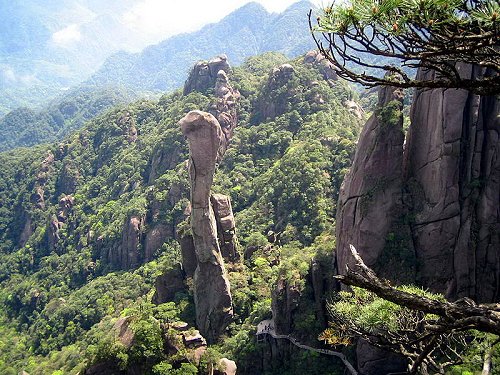China's Second National Communication
Project Overview
The creation of a National Communication offers countries the opportunity to contribute with technically sound studies and information that can be used for designing mitigation and adaptation measures, and project proposals that can and will help increase their resilience to the impacts of climate change. Activities generally include: V&A assessments, Greenhouse Gas Inventory preparation, Mitigation Analysis or Education, and awareness raising activities.The ultimate goal is the integration of climate change considerations into relevant social, economic and environmental policies and actions.
The People’s Republic of China (hereinafter referred to as China) is located in the eastern hemisphere and the west coast of the Pacific, and in East Asia. With a human development index ranking of 89 out of 169, China’s ranking is average for the region, although inequality within the country gives rise to varying levels of development along regional and rural-urban lines (UNDP, 2010). As a result of its rapidly growing economy, China is in a unique position of being one of the major international contributors to global greenhouse gas emissions, but is also highly vulnerable to the impacts of climate change due to its economy, society and natural environment.
To view progress on China's SNC click here.
Project Details
The People’s Republic of China (hereinafter referred to as China) is located in the eastern hemisphere and the west coast of the Pacific, and in East Asia. As a country covering 9,596,961 square kilometers containing over 1.3 billion people, China is by far the largest country in the region in terms of both geography and population (CIA, 2011). With a human development index ranking of 89 out of 169, China’s ranking is average for the region, although inequality within the country gives rise to varying levels of development along regional and rural-urban lines (UNDP, 2010). As a result of its rapidly growing economy, China is in a unique position of being one of the major international contributors to global greenhouse gas emissions, but is also highly vulnerable to the impacts of climate change due to its economy, society and natural environment.
China advocates joint and coordinated efforts of the international community to tackle climate change, and has made positive efforts in this regard. China has participated in the international talks on implementing the “Bali Road Map” and reinforcing the full, effective and sustained implementation of the UNFCCC and its Kyoto Protocol. In its position paper on the Copenhagen Climate Change Conference, China expresses its willingness to make the most sincere and greatest efforts to make the meeting a success. China’s climate is characterized by the distinct continental monsoon climate and the complex climate types, which provides complex and multiple natural background and different environments for various human activities. In the meantime, it also frequently gives rise to natural disasters, threatening social and economic activities. East China is one of the regions in the world with typical monsoon climate. The warm and humid airflow, which the summer monsoon brings from the sea, carries abundant rainfalls and provides a desirable natural environment. However, a concentrated rainfall also tends to cause disasters such as floods, storms and storm tides.
Located deep in the hinterland, Northwest China lacks surface water owing to its inactive water circulation, and has a typical continental dry climate, which results in a fairly fragile natural and ecological environment. Because of its high elevation, the Qinghai-Tibet Plateau has a special plateau climate with annual average temperature below 0 degrees Celsius in most part. The seasonal change of temperature in China is quite prominent. In most regions, there are 4 distinct seasons, with cold winter and hot summer. According to the temperature indicator, the country is divided into 5 zones from south to north, i.e. tropical, subtropical, warm temperate, temperate and frigid zones. The seasonal changes of temperature in most regions of China are fiercer than that of other regions in the world with the same latitude (China’s Policies and Actions for Addressing Climate Change - The Progress Report 2009, November, 2009; China's Initial National Communication, 10 December 2004).
Adaptation Needs and Priorites:
The process of climate change has begun in China, with average temperatures in winter time having already shown an increase of about 0.5oC between the 1970s and the early 2000s (PRC, 2004). Chinese scenarios predict this trend will continue, with a mid-century rise of 2 to 3oC. Although China’s internal modeling and forecasting capacity is likely one of the most advanced in the region, uncertainties remain within studies conducted to date, (PRC, 2004).
Given China’s great expanses of inland areas as well as shorelines and islands with vulnerable ecosystems, China faces a large variety of potential climate change impacts and requires an adaptation response that an address an extremely wide variety of potential impacts. Some of these needs were identified in China’s Initial National Communication to the United Nations Framework Convention on Climate Change (UNFCCC) submitted in December 2004 (PRC, 2004). Within it, the sectors identified as having priority adaptation needs are water resources, agriculture, terrestrial ecosystems and coastal zones. Climate change effects are projected to have a significant impact on water resources, with the intensity of both drought and floods expected to increase. In the agricultural sector, warmer temperatures are expected to extend growing seasons, but this potential benefit could more than be offset by decreases in crop output and fertility, leading to an overall decline in agriculture production (PRC, 2004). In addition, the increased likelihood of extreme weather events could have a very negative impact on the agricultural sector. Threats to biodiversity are also expected. Sea level rise is expected to be significant, particularly in the southern areas, rising as much as 23 centimeters by 2050. This change could lead to significant erosion and intrusion on deltas.
China has identified a number of priorities for adaptation in its initial National Communication in the sectors of water and agriculture, including:
Freshwater Resources:
- Establishing a modern water conservancy management system and strengthening the unified management and protection of water resources;
- Building up water-saving agriculture and industry, vigorously popularizing water-saving irrigation, developing sprinkle irrigation and dripping irrigation, extending the use of water-saving facilities so as to increase water use efficiency;
- Increasing the capacity of reservoirs and river dams to prevent floods, tapping water sources to increase water-supply capacity, planning and building the trans-valley water converting project and achieving optimized allocation and utilization of water resource cross valleys;
- Enhancing the protection and building of ecosystems, restoring vegetation cover, preventing and controlling soil erosion and loss; and
- Protecting the water environment, preventing and controlling the water pollution, increasing the rate of treating sewage, improving the renewal and utilization of sewage, achieving the benign cycle of the ecology and environment.
Agriculture:
- Adjusting the agricultural structure and the cropping system, such as through expansion of the area of paddy-rice fields in the areas of northeast China, and a shift from the dual structure in the traditional farm production in some areas in China to a ternary structure of coordinated development of food crop, fodder crop and cash crop, etc.;
- Raising multiple cropping indexes;
- Selecting, cultivating and popularizing stress-resistant varieties;
- Improving management measures, such as through active popularization of water-saving agricultural measures, technologies of optimized fertilization and deep fertilization, and technologies of comprehensive prevention and control of soil erosion; and
- Constructing and improving agricultural infrastructures, such as through fundamental construction of farmland, fundamental construction of water conservancy, building the agricultural ecosystem, construction of farmland with high and stable yields, conversion of unduly reclaimed land to pasture.
China stresses that it faces a “dual pressure” on climate change by having both economic development and environmental protection barriers to overcome, particularly in relation to technology development. Despite its recent economic prowess, China remains a developing country and faces barriers to adaptation implementation. China stresses a need for funding, technology and capacity building to meet its climate change goals.
National Level Policies:
China has a long list of environmental and sustainable development policy plans that it has implemented over the years. Its National Communication to the UNFCCC also highlights a long list of sectoral policies it has put in place to support adaptation action. As part of its 12th Five-Year Development Plan, China is expected to develop a national Climate Change Plan to address climate change issues along with economic development. How much focus this plan will have on adaptation will be seen when the plan is published in March 2011. China has taken on a number of policies and actions that have adaptation benefits nationally. Since 2008, China has been issuing an annual report, China’s Policies and Actions for addressing Climate Change, which summarizes progress on internal policies.
Current Adaptation Action:
Over the past several years, China has attracted a considerable amount of climate change funding; however, a large majority of this funding has been directed to mitigation and the energy sector. For example, China has secured nearly half of a billion dollars for climate change projects through the GEF but only a small percentage is funding is for adaptation initiatives. Nonetheless there are a number of ongoing adaptation activities within the country supported through international partners—the majority of which are regionally-focused projects—that address China’s adaptation priorities.
Current nationally focused adaptation projects within China are focused most prominently on adaptation within the agriculture and water sectors, as well as land use management and meteorology. Project activities include capacity building, policy formulation, pilot project implementation, vulnerability assessment and community based adaptation. China is participating in a considerably larger number of regionally-focused projects. These regional projects are primarily focused on water, agriculture, and policy formulation and implementation, with one or two active projects addressing adaptation in the areas of health, nature, urban areas, risk reduction and meteorology. Gender is not a prominent component of either national or multi-country projects in China at present. Leading funders of adaptation action in China include: the Asian Development Bank (ADB), Asia-Pacific Network for Global Change Research (APN), the Special Climate Change Fund (SCCF) and the governments of Norway and Switzerland.
Assessment:
China is making considerable strides in addressing climate change through its various policies as well as participation in a number of projects that address its priority adaptation needs. Given the importance placed on climate change mitigation within the country, it is possible that adaptation is receiving less focus than is warranted. Nonetheless, China has the scientific and technical capacity needed to address its adaptation goals, and has demonstrated that it is cognizant of its adaptation priorities. At the same time it has shown the ability to enact large-scale policy reforms to achieve climate change goals.
China does have significant adaptation issues that need to be addressed and is making progress to meeting these goals. For example, it appears that the country has made considerable advancements in addressing climate change in the agriculture and water sector, two of its key adaptation priorities. However gaps persist in other areas, including in the priority areas of coastal zones and terrestrial ecosystems.
Primary Source:
- Gass, Philip; Hove, Hilary; Parry, Jo-Ellen. (2011) “Review of Current and Planned Adaptation Action: East and Southeast Asia.” Adaptation Partnership / International Institute for Sustainable Development.
Additional References:
- Central Intelligence Agency [CIA] (2011). East & Southeast Asia: China. The World Factbook. Retrieved fromhttps://www.cia.gov/library/publications/the-world-factbook/geos/ch.html
- People’s Republic of China (2004). Initial National Communication on Climate Change. Retrieved from http://unfccc.int/resource/docs/natc/chnnc1e.pdf
- United Nations Development Program [UNDP] (2010). Human Development Index 2010. Retrieved from http://hdr.undp.org/en/statistics/
Key Results and Outputs
Potential Adaptation Measures
Agriculture and Food Security
- Switch to different cultivars
- Enhance irrigation efficiency and/or expand irrigation
- Develop new crops
- Develop early warning systems and disaster preparedness
- Improve pest and disease forecast and control
Water Resources
- Develop and introduce flood and drought monitoring and control system
- Improve or develop water management
Coastal Zones and Marine Ecosystems
- Protect, including building sea walls, and beach nourishment
- Data investigation/collection/analysis, and database establishment and improvement;
- Field investigations and sampling analysis;
- Development and improvement of model for quantifying volume of municipal solid waste;
- Evaluation of the CO2 emission factors of waste incineration systems, the CH4 emission factors and N2O emission factors of industrial wastewater treatment systems and residential wastewater treatment systems;
- Estimation and compilation of GHG emissions inventory in each category of waste treatment;
- Summary analysis and finalization of China’s 2005 GHG inventory from waste treatment.
- Activity data collection and quantification methods, and activity data for for each source category of wastewater / sewage treatment;
- Emission factors for each source category of wastewater / sewage treatment.
- China’s GHG inventory in waste treatment;
- Report of the inventory compiling methodology for GHG emission inventory of waste treatment sector
Monitoring and Evaluation
In 1992, countries joined an international treaty, the United Nations Framework Convention on Climate Change, to cooperatively consider what they could do to limit average global temperature increases and the resulting climate change, and to cope with whatever impacts were, by then, inevitable.
Parties to the Convention must submit national reports on implementation of the Convention to the Conference of the Parties (COP). The required contents of national communications and the timetable for their submission are different for Annex I and non-Annex I Parties. This is in accordance with the principle of "common but differentiated responsibilities" enshrined in the Convention.
The core elements of the national communications for both Annex I and non-Annex I Parties are information on emissions and removals of greenhouse gases (GHGs) and details of the activities a Party has undertaken to implement the Convention. National communications usually contain information on national circumstances, vulnerability assessment, financial resources and transfer of technology, and education, training and public awareness.
Since 1994, governments have invested significant time and resources in the preparation, collection and validation of data on GHG emissions, and the COP has made determined efforts to improve the quality and consistency of the data, which are ensured by established guidelines for reporting. Non-Annex I Parties receive financial and technical assistance in preparing their national communications, facilitated by the UNFCCC secretariat.





